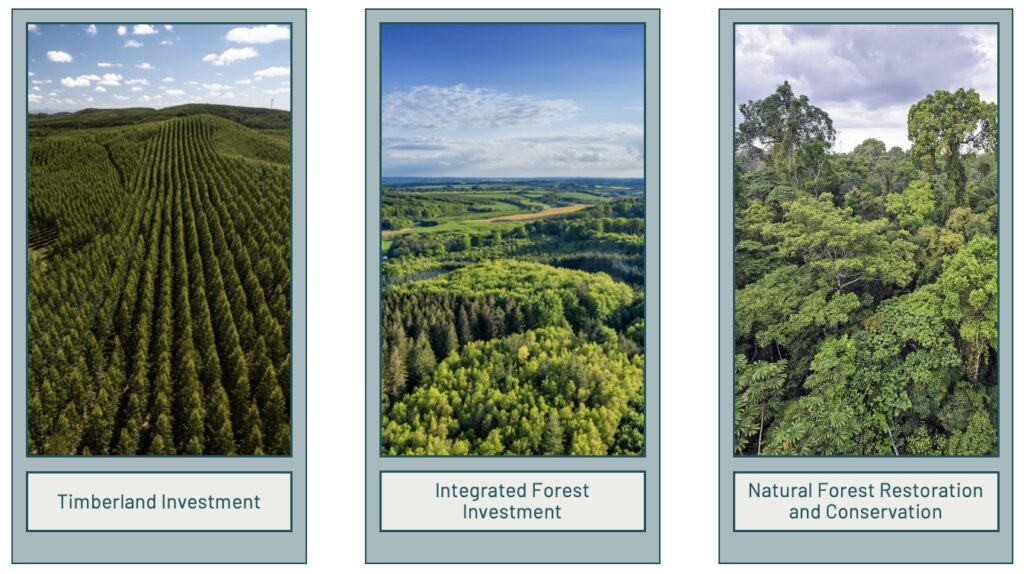Don’t be the TIMO that gets left behind! Learn more about The ForestLink’s Timberland Upgrade Service. Build on the strength and success of your timberland investment approach to meet the sustainability needs of today’s investors. |
The prescription for an aging TIMO with a sustainability deficiency
When it comes to allocating capital to forest assets, I see three main philosophies.
- Timberland investment
- Integrated forest investment
- Natural forest restoration and conservation investment
My philosophy and the work I promote is to meet in the middle, combining the economic strengths of timberland investment and the forest ecosystem resilience of forest restoration and conservation into an integrated model. Of course, no single forest asset will look like another, and some assets will naturally lean more heavily on the timber production side, and some will lean more heavily on the restoration or conservation side – but you would be hard-pressed to find an asset where you can’t bring in elements of the two extremes to strengthen the long-term sustainability of the forest you are investing in.

On the one hand, this approach is good for the forest, on the other – it’s a necessity for many investors. Fear of greenwashing cannot be underestimated. This article by Corporate Knights highlights hefty corporate fines issued to green-washers. This is a risk for timberland investment if you package up a business-as-usual timber optimization approach and try to sell it as something more. Tags such as: “nature positive”, “climate resilient”, “sustainable”, and “impact” can get you in trouble if you don’t have the systems in place to manage for, monitor and report on these other forest benefits.
This article focuses on the evolution of the timberland investment philosophy, into a more integrated forest investment approach.
Why Change a Proven Timberland Investment Approach?
Modern timberland investment gained prominence in the 1980s with the emergence of timberland investment management organizations (TIMOs), offering a diversification strategy for institutional investors seeking stable returns. The approach combined professional investment structuring and management together with specialized forest management expertise for timber optimization. Timberland investments are appealing to institutional investors seeking long-term appreciation. Timberland is traditionally uncorrelated to the financial performance of other asset classes and is an inflation hedging strategy, where forest assets gain value from biological growth and provide flexibility in harvest timing, where investors gain income from timber sales.
Timberland investment has also been on an evolving path of sustainability. From the business-as-usual compliance with forest management regulations through to meeting the increasing demand for voluntary management of ecosystem services (like climate and biodiversity) and social objectives.
I believe that the later, with integrated ecosystem services and social benefits is becoming the new BAU. This doesn’t mean throwing out timber optimization, it means credible integration of these other values, alongside timber objectives. When I say credible, what I mean is, don’t be tempted into word-smithing your traditional timberland approach, but instead – identify tangible and demonstrable ways ecosystem services and social benefits can be brought into the way you manage forest assets.
Let’s take a look at why you might need a timberland upgrade, to expand your sustainability credentials and build your business.
Symptoms of an Aging TIMO
Are you an aging TIMO with a sustainability deficiency? Have a look at the following symptoms and see how you
1. Competition with TIMO peers (or new natural capital asset managers)
You have observed your peers having evolved language and investment offerings in the natural capital space. They may refer to other revenue generation streams, they may describe targets relating to biodiversity, climate, social or other non-traditional economic objectives. Additionally, there are new kids on the block, new asset managers on the scene, competing for both investors and deals.
2. Challenged market access (Investors and end markets)
Investors are coming to you with questions about different sustainability regulations, such as the SFDR, or voluntary disclosure recommendations, such as TCFD (now incorporated into ISSB), TNFD and adherence to the SBTi FLAG Guidance. They may be asking you to report on certain metrics that you have never considered before – such as biodiversity footprint or Scope 3 emissions. You are concerned that you won’t be able to meet investor’s needs with respect to these asks, and that your investors will go elsewhere if they are unable to achieve the sustainability credentials they are seeking in a forest investment manager.
In addition to the market for investors, there is also the market for ecosystem services. The Voluntary Carbon Market (VCM) has taken the world by storm these last few years. As the market irons out kinks on its highly intangible outputs and the market matures, buyers are setting high standards for co-benefit creation – that is the tangible social and nature outcomes associated with carbon projects. Thinking that a 10,000ha eucalyptus plantation will bring in a nice upside revenue to your traditional wood market play is looking less and less likely – unless you credibly up your impact game.
3. Reputational risk
The media is alive and well in the climate and nature space, and forest investment is a natural target. Are you concerned that you would be a low-hanging fruit for the media to scrutinize your sustainability. To avoid this, you need your forest investments to be structured in such a way that ESG risks are reduced, and environmental and social benefits can be managed for and demonstrated. I wrote an article on 10 steps to safeguarding your forest assets from media attacks.
4. Restrictions from entering new investment jurisdictions
The timberland investment universe is arguably saturated. The same assets in the same core markets are regularly changing hands with the same investors. Several TIMOs are moving into emerging and frontier markets, expanding the universe. However, the traditional timberland model lacks the more robust ESG risk management and impact objective setting required by these markets – both to secure investors, and for the asset to be a financial success. Investors attracted to these markets have higher sustainability demands. What’s more, the nature of forest governance, market maturity and other factors in emerging and frontier markets require the investment manager to take on responsibilities that in core markets are borne by legislation, public authorities, or other parties.
Start Your Timberland Investment Upgrade Today
If you have steadily been checking the list above, or even if you tick one that is particularly concerning – it might be time to consider an upgrade to your Timberland investment approach. Check out The ForestLink’s Timberland Upgrade service, that is designed to effectively address your concerns and reach your goals for credibly improving the sustainability credentials of your organization, a particular mandate, or a specific asset. Book a call to learn more.
Did you like this article? Sign up now for the ForestLink’s newsletter, where you’ll receive technical advice, reflections, and best-practice guidance to support you with your forest-linked investment strategy or business straight to your inbox.





